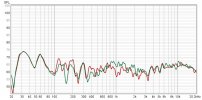ernestcarl
Major Contributor
Correction of reflexes ( different than resonances ! ) higher than 80 Hz can sound better, but just in one listening spot.
I mostly agree. But I do have a relatively small but visually noticeable "peak" at 300Hz from my main right loudspeaker present in most of the 9 different listening positions I've measured in my room -- both from over 9 multi-point sweeps and 5 separate sets of MMM measurements for that single speaker alone. That peak is absolutely not present in any of my quasi-anechoic measurements. Audible or not, I reckon a small reduction would not be harmful or detrimental based on the data. *I forgot to mention I also have a 3dB boost at 100Hz for the left main and 126Hz for the right -- which, again, from my several measurements throughout several listening spots in the room proved slightly beneficial / at the very least largely benign rather than harmful.
2. Measure with a good measurement microphone and a program like REW on axis about 50 cm up till 1 metre distance from the loudspeaker . Use a pulse window of 5 ms. Measure at 0 degrees, 15 degrees, 30 degrees. Use the ”average” function in the loudspeakerprogram.
This is what I would generally do myself, but with the addition of some vertical curves. I also found it beneficial to use as an additional "reference curve" that is derived from multiple sets of MMM throughout the listening areas per individual speaker. One can load EQ corrections to both MMM and quasi-anechoic curves at the same time / side-by-side to see how changing one affects the other.
Last edited:











